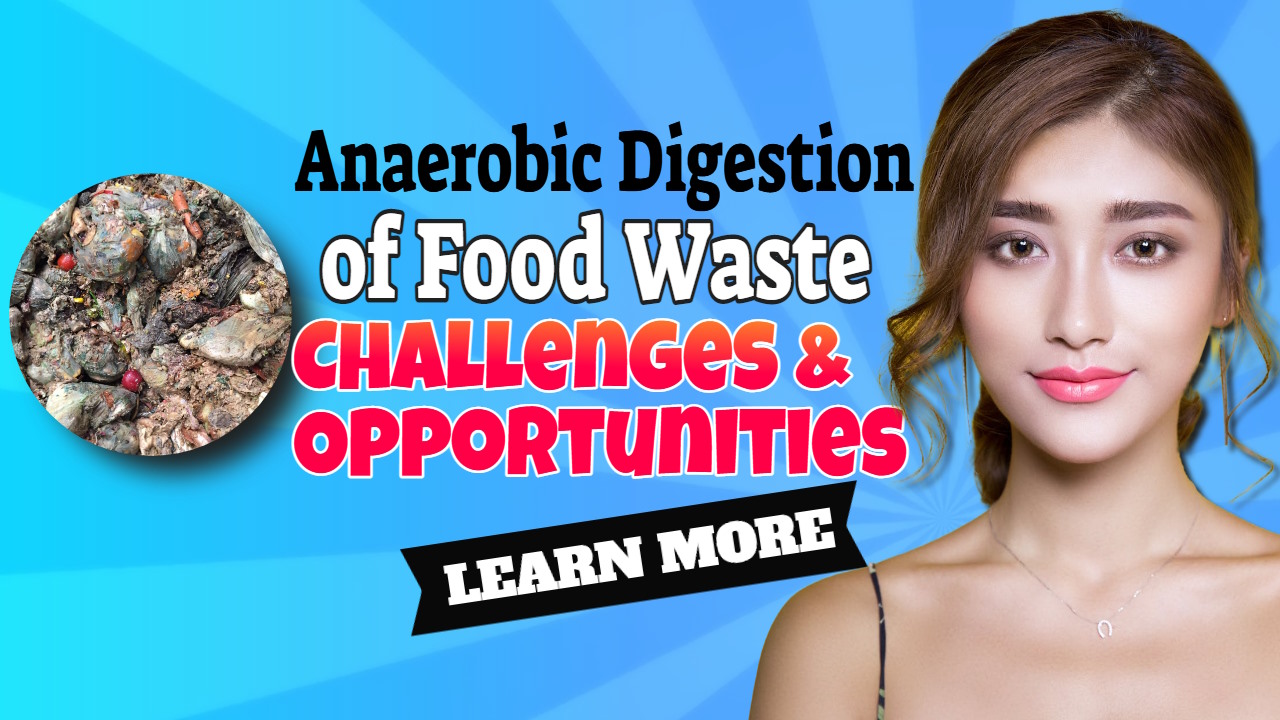Food waste is acknowledged by the scietific community to be one of the major problems contributing to the degradation of environment, and it requires serious attention. Among the different options, anaerobic digestion is probably the most effective method for managing degradable waste and producing renewable energy and fertilizer.
Anaerobic digestion processes organic materials into biogas and a nutrient-rich effluent. This biogas can be burned to generate energy or land-applied as a valuable biofertiliser. This helps to reduce the UK's dependence on fossil fuels and carbon emissions.
Anaerobic digestion of food waste is a climate-friendly option for diverting decaying organic material from landfills. This reduces greenhouse gas emissions, which are a major contributor to climate change.
1. Biodegradation rate
Food waste utilisation is a challenge. If allowed to rot in landfills food waste is a major source of environmental pollution. It is generated in large amounts by households, businesses, and institutions. It took a lot of skill and energy to make it, and to simply trash it is an enormous waste of resources. The disposal of this waste either through burning or land filling has negative impacts on the environment.
Anaerobic digestion of food waste can degrade food waste into biogas and byproducts such as organic fertilizer. This process is a viable option for decarbonizing and degrading waste, especially as the global climate crisis continues to worsen.
2. Biogas
Biogas, produced during the anaerobic digestion of food waste is a massive opportunity. In anaerobic digestion, organic matter is broken down in the absence of oxygen. This biogas is used to generate renewable energy, such as electricity and heat.
Anaerobic digestion has a positive environmental impact because it uses waste that otherwise would have gone to landfills or manure lagoons. It also helps mitigate greenhouse gas emissions by converting methane to carbon dioxide.
The amount of biogas produced depends on the type of organic matter and its retention time in the digester. The higher the volume of biogas produced, the more efficient it is in converting organic matter into energy.
3. Energy
Energy recovery from food waste is a big opportunity. The energy produced from anaerobic digestion can be used to fuel industrial processes and generate electricity. It also helps decarbonize communities, which reduces their reliance on polluting fossil fuels and supports local economies by generating much-needed revenue through the production of renewable biogas and power.
Food waste is one of the easiest parts of the waste stream to tackle, and it is a particularly receptive feedstock for anaerobic digestion. As such, there are several companies and municipalities working to develop anaerobic digesters for food waste.
4. Chemicals
Chemical production from the outpuits from the anaerobic digestion of food waste is also an opportuinty. Anaerobic digestion is a natural process that involves bacteria breaking down organic material without oxygen. This produces biogas, which is mostly methane (CH4) and carbon dioxide with trace amounts of water vapor and other gases.
The gas is collected and used in a number of ways. It can be used as a source of renewable energy for power generation and it can also be applied on farmland to fertilise soil, helping sequester carbon emissions which contribute to climate change. And, of course methane from biogas, can be used instead of non-renewable oil as the starting point for chemical refineries hat until now hav been using oil to make long-chain polymeric materials such as plastics.
5. Fertilizer
The anaerobic digestion process can also be used to make a chemical fertiliser replacement. In the early stages of anaerobic digestion, organic waste is broken down by bacteria in the absence of oxygen into a mixture called digestate. This is a liquid fertiliser that is rich in nutrients and can be used on farmland to enrich soil without the use of fossil fuel derived fertilisers.
So, anaerobic digestion produces nutrient-rich biofertilizer that can be used to grow crops instead of the chemicals typically used for fertilization. This is a huge win for farmers and the environment alike!
6. Perhaps the Biggest Challenge of Wasted Food is that:
While there are many obstacles that must be overcome, changing people's behaviours and attitudes towards food may be the most difficult.
People often buy more food than they need and then toss out the extra or the spoiled stuff. A sign of plenty or generosity, food waste is celebrated in some societies.
To get past this obstacle, we need to get the word out about how damaging food waste is to the ecosystem, the economy, and the social fabric of our communities, and then offer workable strategies for cutting down on it.
People's perspectives and practises regarding food waste can be altered through educational campaigns, outreach programmes, and incentives like discounts on groceries for donating excess food to food banks.
Reducing portion sizes and improving food storage and packaging are two additional strategies for minimising food loss and waste.
7. The Depackaging Challenge
The highest challenge for the recycling industry when depackaging food waste is the waste stream's high level of contamination and variability.
Plastics, metals, glass, and organic matter are frequently found in food waste, and these materials are frequently mixed together in packaging. This makes it difficult to separate and process the various components effectively.
Non-food contamination can also reduce the quality and value of the end product, making it less appealing to potential buyers. Furthermore, because waste streams vary, recycling facilities may need to modify their processes and equipment to accommodate different types and quantities of materials.
To address these issues, the recycling industry must invest in better sorting and processing technologies while also educating consumers and food producers on proper packaging and disposal practises.
Partnerships between the food and packaging industries, as well as recycling facilities, can also help promote more sustainable packaging solutions and reduce waste contamination.
On a Humorous Note:
"Why did the tomato turn red and angry? Because it saw the amount of food waste in the trash can and couldn't ketchup with the idea!"
Summary
The article discusses the problem of food waste, which can pollute the environment, as well as the opportunities for utilising it through anaerobic digestion. This biogas can be used to generate renewable energy, power industrial processes, and even produce chemicals and fertilisers.
However, changing people's attitudes and behaviours towards food waste remains a significant challenge. Food waste depackaging is also difficult due to high levels of contamination and variability.
To address these issues, the recycling industry must invest in better sorting and processing technologies, educate consumers and food producers on proper packaging and disposal practises, and promote more environmentally friendly packaging solutions.
Conclusion
Anaerobic digestion is a process that converts organic waste to renewable energy in the form of biogas. During this process, microbes break down food waste and manure into methane and carbon dioxide.
These gases are then combusted to create electricity. The resulting biogas is an alternative, renewable source of energy that can be utilized for power generation.
The clock is ticking, and time is of the essence. The environmental impact of food waste cannot be ignored any longer. We must all take responsibility and contribute to reducing food waste, whether through composting, recycling, or simply being more conscious of what we buy and consume.
Our actions today will determine the fate of our planet for future generations. Let us work together to make the world a more waste-free and sustainable place.
The stakes are far too high to overlook. Our planet's future is in our hands, and every action counts.
Let's make a difference and get started right away!


